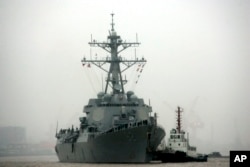China has taken a wide technological lead to help bolster its control over much of Asia’s most contested tract of sea, an advantage that analysts say will help keep less equipped countries away from Beijing’s massive maritime claims.
Beijing showed its technological reach in the South China Sea last month when one of its naval lifeboats picked up a U.S. underwater scientific research drone 93 kilometers from the Philippines, which has a weaker navy and said it was unaware of the incident. The U.S. government protested and China – which accuses Washington of trying to contain its expansion -- eventually returned the drone.
Ability to monitor activity
China can handily detect the activity of other countries with advanced technology such as radars, aerial drones and at least one satellite covering parts of the sea’s Paracel and Spratly island chains, analysts say. Other countries lack the budget or the knowhow to vie with China’s maritime technology, which is has unfolded since around 2010 for an undisclosed amount of money.
“China can use their technology or use defense to claim that we have strengthened our holding or our control, or administration or even our scientific research in the South China Sea,” said Yun Sun, East Asia Program senior associate at the Stimson Center think tank in Washington. “In the long run it is one way that could matter.”
Tech strengthens legal claims
Use of superior technology may bolster any future challenges to Beijing’s legal claims, Sun said. A world court arbitration tribunal ruled in July against China’s claim to about 95 percent of the sea using historical records. China rejected the verdict.
“The Chinese can come up with a list of the equipment they deployed in the region and show that as evidence of sovereignty,” she said.
The tropical sea covers 3.5 million square miles stretching southwest from Taiwan past China to Singapore. It’s rich in fisheries, shipping lanes and possible fossil fuel reserves. Brunei, Malaysia, Vietnam, Taiwan and the Philippines also make claims. The United States is not a claimant but insists on freedom of navigation. American military technology can, at the very least, match China’s. But Washington does not make any permanent deployments of assets in the South China Sea.
China ahead of all others
Vietnam, which has sparred with China occasionally at sea since the 1970s, owns viable technology for use above the ocean surface but lacks China’s underwater sophistication, said Collin Koh, a maritime security research fellow at Nanyang Technological University in Singapore. Other claimants lag further, he said.
“The other claimants, they are more or less still stuck with the more traditional forms of surveillance such as the case of aerial and surface technology,” Koh said, “We’re faced here (with) a very a non-uniform, uneven proliferation of new technologies in the South China Sea.”
Chinese technology can gauge which islets are suitable for tourism, commerce or land reclamation, Sun said. Much of it developed at home, Chinese high-tech equipment is expected someday to create barriers around existing military facilities at sea.
Chinese military will benefit
Beijing’s China State Shipbuilding Corp. proposed last year deploying a network of ship and subsurface sensors to deter foreign vessels, defense publication IHS Jane’s 360 reported. That network aimed at bulking up China’s long-term ability to control the sea was named an “Underwater Great Wall Project.”
The same company has systems for marine observation, underwater robotics and ship support, IHS Jane’s 360 says. Specific components, it says, include sonar systems, underwater security equipment and underwater unmanned equipment.
Drones designed in China for use in the disputed sea can do “complicated surveying,” the Chinese state-controlled People’s Daily online said in September. One drone can fly up to 1,400 kilometers and stay airborne 30 consecutive hours, the news outlet said, calling the design “especially stealthy.”
Tech helps claims for sovereignty
A month after the world court verdict against Chinese claims, Beijing deployed its Gaofen 3 satellite to capture high-resolution images of islets, ships, oil rigs and weather at sea, the official China Daily newspaper said.
China might eventually invite foreign representatives to visit a future high-tech installation at sea, a way to flex its claim to sovereignty, Sun said.
Other claimants, especially Vietnam and the Philippines, have protested against China’s militarization of the sea, especially as Chinese vessels enter the ocean exclusive economic zones demarcated by those countries.
In Malaysia, which claims part of the Spratlys and has been ranked as the sea’s top oil and gas prospector, much of the public worries about a buildup of Chinese technology, said Ibrahim Suffian, program director with Kuala Lumpur-based polling group Merdeka Center.
“There’s a general understanding that Malaysia is a small country with limited ability, so the best strategy is avoid a conflict,” Suffain said. “They do not like the idea of China increasing the military hardware and technology in that area. They also do not want other powers like say the U.S. to increase its presence.”









